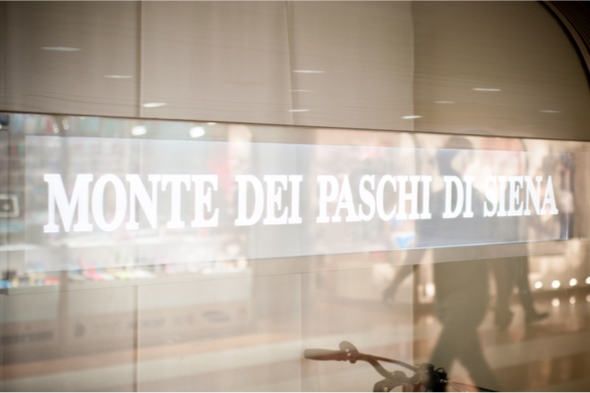Founded in 1472 as a charity to lend to the poor of Tuscany, Banca Monte dei Paschi di Siena (“MPS”), the Italian third largest commercial and retail bank by total assets, is considered the oldest operating bank in the world.
Disastrous deal
After its listing on the Italian Stock Exchange in June 1999, the Tuscan bank began an intense phase of commercial and operational expansion, which culminated on 8 November 2007 with the announcement of the acquisition of rival regional lender Antonveneta for EUR 9 billion (EUR 6 billion of which was for goodwill) in cash from Banco Santander, which had paid for it plus Interbanca EUR 6.6 billion only a few months earlier. This disastrous deal, already at that time harshly criticized by many market participants (MPS shares plunged more than 11% the day after the announcement, giving it a market capitalization of EUR 10 billion), marked the beginning of the financial crisis that has engulfed the bank.

To finance the purchase of Antonveneta, in January 2008 MPS launched a capital increase of EUR 6 billion, borrowed a further EUR 1 billion and secured the remaining EUR 2 billion through the issuance of subordinated bonds. Since then, in order to boost its capital base, the Italian State had to underwrite bonds issued by the bank twice (in 2009 the so-called “Tremonti bonds” and in 2013 the so-called “Monti bonds”) for a total of EUR 4.1 billion. Additionally, it raised its capital a second time in 2011 for EUR 2.15 billion, a third time in June 2014 for EUR 5 billion (from EUR 3 billion previously planned) and a fourth time in 2015 for EUR 3 billion (from EUR 2.5 billion previously planned).
After accounting EUR 2 billion writedowns on bad loans (i.e. its eight consecutive year of writedowns on bad loans for a total of EUR 20.3 billion), in January 2016 MPS announced a net profit of EUR 390 million for 2015. Nevertheless, without a gain of around EUR 500 million from the restatement — requested by market watchdog Consob — of a controversial derivative trade and taking into account one-off items, the bank would have posted a net loss of EUR 110 million (i.e. its fifth consecutive year of losses for a total of EUR 14.7 billion).
Notwithstanding the catastrophic situation described above, it is time for a next EU health check (results are to be disclosed on 29 July 2016) and what is the news for MPS? In anticipation of its results, the ECB has recently requested to the Tuscan bank to sell by 2018 EUR 9.6 billion of its net (of provisions) non-performing loans (“NPLs”). Banking analysts estimate that the ECB’s demand could require additional writedowns of around EUR 4 billion, forcing MPS to tap the market for up to EUR 7 billion.
One simple question here: who is to blame?
- Firstly, the bank’s largest and controlling shareholder until the 2013 bailout, namely the charitable foundation based in Siena (Tuscany) “Fondazione Monte dei Paschi di Siena”. The foundation, dominated by local politicians, used to appoint half of the bank’s board of directors, including the chairman. Managers have sacrificed the efficiency of the bank to serve the interests of their political patrons.
- Secondly, MPS’s former and new management (i.e. the management appointed in 2012). The bank’s current crisis is in large part undoubtedly to be ascribed to reckless choices made by the previous management and in particular by Giuseppe Mussari (chairman from 2006 till 2012), Antonio Vigni (general manager from 2006 till 2012), and Gianluca Baldassarri (chief of finance from 2001 till 2012). In October 2014 a court in Siena sentenced Giuseppe Mussari, Antonio Vigni and Gianluca Baldassarri to 3.5 years in prison after being found guilty of giving false statements to the market and regulatory obstruction in relation to the purchase of Antonveneta and risky derivatives trades designed to conceal mounting losses. As for the new management, with Fabrizio Viola (surprisingly still the current CEO) and Alessandro Profumo (chairman until July 2015), it started cleaning up the bank’s balance sheet with the approval of the 2011 financial statement. However, despite the sale of assets, the closing of branches and the layoffs of thousands of workers, MPS continues to report losses, amid restatements of financial accounts to comply with Consob’s requests (the last of which dates back to December 2015), and to have dire need of money.
- Thirdly, the Bank of Italy and the Consob. If yet needed, MPS is a further proof that in case something goes wrong there is no one in the Italian market that can prevent investors from suffering losses. In particular, the Bank of Italy, under former governor Mario Draghi (current president of the European Central Bank), authorized the acquisition of Antonveneta without conducting any due diligence before agreeing the deal.

No surprise then if the final cost exploded from the EUR 9 billion announced to the astronomical figure of EUR 17 billion. Furthermore, it is reported that it spotted accounting irregularities that allowed MPS to mask losses more than two years before the bank was forced to restate profit.
Yet, where was the Bank of Italy when MPS’s portfolio of NPLs reached warning size?
As for the Consob’s responsibilities here it is sufficient to mention the several false statements (and consequently prospectuses) approved by both the former and the new management.
An advertising campaign launched in early 2007 dubbed MPS “An Italian story since 1472”. With a current market capitalization of less than EUR 900 million, the recklessness of a few people, combined with poor management and “sleeping” authorities, has earned the bank an infamous nickname: “An Italian story of incredible value destruction”.

Written on July 29, 2016 by
Rosario Marcone
Deminor Recovery Services – Country Manager Italy. Responsible for promoting and managing Italian cases in the three core business area of Deminor Recovery Services: Investment Recovery, Antitrust Damages and Commercial Litigation



